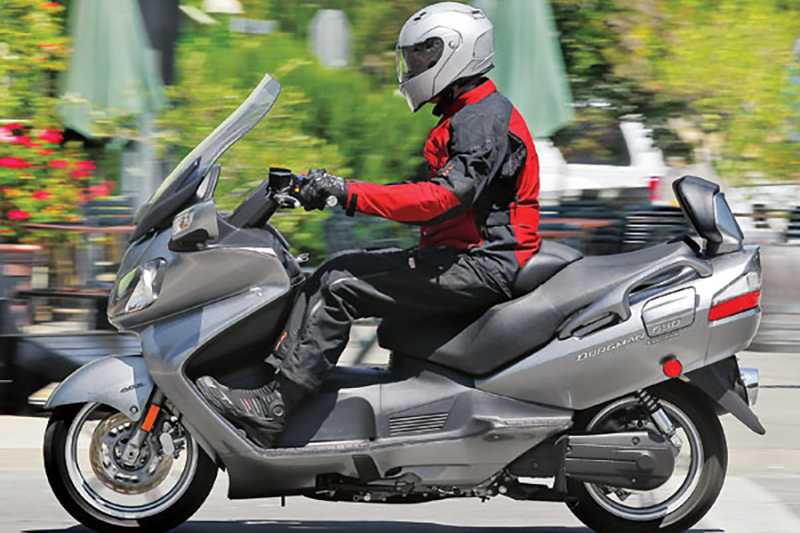2011 Suzuki Burgman 650 Executive

Road Test
Over the past few years we’ve tested quite a few machines with “automatic” transmissions: the SE5-equipped Can-Am Spyder, the electric-shift Yamaha FJR1300AE, the dual-clutch Honda VFR1200F DCT, the hydromechanical HFT-equipped Honda DN-01, as well as CVT-equipped scooters and the Aprilia Mana 850. The underlying technologies and rider interfaces differ, but all twist-and-go transmissions are designed to make gear changes simple and efficient. Motorcyclists often look askance at two-wheelers lacking a manually operated clutch, silently casting aspersions toward those assumed to lack skills or strength. To each their own, I say. Automatic shifting frees up mental bandwidth to enjoy the ride, as I found flogging a scooter around Thailand for four days (Rider, June 2010).
Between the engine and rear wheel of the Suzuki Burgman 650 Executive, the maxi-est of the maxi-scooters, is the Suzuki Electronically-Controlled Continuously Variable Transmission, or SECVT if you prefer five letters instead of 62. Among the left handlebar’s many multicolored buttons that control eight separate functions, three regulate the SECVT: a gray one toggles between two fully automatic modes (power or drive), a yellow one toggles between automatic and manual shift modes and an orange one toggles between six predetermined CVT ratios in manual shift mode. (The other buttons switch between high and low beam, flash the headlight, signal turns, bleat the horn and electronically retract the mirrors.)
According to Shinobu Tsutsumikoshi, a Suzuki engineer who helped develop the SECVT, “We refined the already-efficient CVT system even further through integrated electronic control of both engine and transmission.” Instead of a conventional centrifugal CVT that uses a rubber belt to adjust the gear ratio, the SECVT varies the drive-pulley diameter with an electric actuator motor. An ECU calculates the target engine speed based on vehicle speed and throttle position, and adjusts the CVT ratio accordingly. The SECVT uses a Dry Hybrid Composite Belt made of H-shaped high-strength aluminum blocks embedded with heat-resistant rubber tension members and covered with resin. The durable belt runs dry to avoid the frictional losses of an oil bath and helps keep the transmission light and compact.
After adapting to the location and function of the SECVT’s buttons, and taking care to override my instinct to pull in the rear brake lever thinking it was the clutch, I quickly cozied up to the SECVT. When shifting is done automatically, drive mode optimizes the CVT ratio for fuel efficiency and power mode optimizes for acceleration. When shifting is done manually, the up/down buttons move between the preset “gears,” identified by a numeral on the LCD instrument panel. And regardless of mode, the SECVT shifts into neutral at a stop. Speeding up and slowing down is seamless, with no need to blip or roll off the throttle.
The Burgman is less of a step-through than most scooters because its engine is located between the rider’s feet. That keeps most of the Burgman’s 620-pound mass low and centralized, almost like a Gurney Alligator with a conventional seating position. Removing the plastic engine cover reveals a 638cc liquid-cooled parallel twin laid down horizontally, packed tightly between tubular steel frame rails. It has a bore/stroke of 75.5/71.3mm, GSX-R-style downdraft intakes, DOHC with four valves per cylinder and a compression ratio of 11.2:1, yet only regular fuel is required. The electronic fuel injection is dead-on, throttle response is crisp and acceleration is brisk (the engine puts out about 50 horsepower). Dual gear-driven countershafts eradicate even a hint of engine vibration and the stainless steel exhaust, which uses pulsed-air injection and a catalyzer to reduce emissions, emits only a modest hum. The Burgman is so smooth and quiet that it’s easy to toddle down the road at 90 mph without realizing it.
With light handling, ample cornering clearance and decent power, the Burgman can be hustled through curves swiftly. The Bridgestone TH01 radials (120/70-R15 front, 160/60-R14 rear) grip the road well and have a nicely rounded profile. Minimal engine braking means that the nonlinked, ABS-equipped brakes must be used to scrub off speed, with the left lever actuating the rear caliper and the right lever actuating the two front calipers (there’s also a parking brake). At times I wished for more braking power, but the Burgman isn’t intended to be a knee-down sportbike. Though easily overwhelmed by fast corners and rough roads, the nonadjustable fork and preload-adjustable rear shocks, with 4.3 inches and 3.9 inches of travel respectively, performed well in most conditions. Setting the rear spring preload is as simple as rotating an external collar on each shock to one of five positions.
If the Burgman was interviewed for a job and asked to identify its three greatest strengths, they would be user-friendliness, comfort and storage capacity. Introduced in 2004, the plush Executive package was once a premium model that’s now the only Burgman 650 offered in the United States, its corner-office features having proven very popular. In addition to ABS, the Executive features an electrically adjustable windscreen, electrically retractable mirrors (for squeezing into tight parking spots or lane splitting), a passenger backrest and chrome bar ends and muffler cover. The Burgman’s wide seat is plush and has an adjustable rider backrest, while rubberized rider and passenger floorboards provide plenty of foot placement options. Beneath the seat is an illuminated, lockable, water-tight, 56-liter trunk that holds two full-face helmets (or a bottle of champagne and a dozen roses, as I found out), plus a toolkit and helmet lock. The cockpit has a locking glove compartment with a 12V socket and two smaller storage compartments. For additional storage Suzuki offers an accessory rear rack ($229.95), and for a real GQ look, it offers a burlwood dash trim kit ($222.95) and front chrome garnish ($139.95). Since many a Burgman will live in urban areas along with their owners, the key fob can be used to engage an ignition switch cover to dissuade screwdriver-wielding joy riders.
The Burgman’s LCD instrument panel conveys a host of information, including speed, rpm, engine temperature, fuel level, odometer/A-B tripmeter/A-B fuel consumption, clock/ambient temperature, drive/power mode, gear position (manual mode), as well as low-oil and oil-change indicators. Factor in eight different indicator lights, and you’ve got one heck of a dashboard! Although the Burgman 650 Executive’s $9,899 price tag is steep by scooter standards, it is very reasonable by middleweight sport-touring standards, the segment in which this maxi-scooter seems to fit best. Our art director Jody loaded up the trunk, strapped on a tailbag and spent a long weekend on the Burgman during Rider’s annual staff ride. She easily kept up with more powerful motorcycles and she appreciated the wind protection and comfortable seating position.
Over the course of our 1,000-mile test, it averaged 43.9 mpg, which is comparable to other 650s we’ve tested and yields about 176 miles from the four-gallon tank. Having been in production since 2003 with few changes, the Burgman 650 has proven reliable. The maintenance schedule is reasonable —change the engine oil every 3,500 miles (filter every 11,000 miles), change the transmission and final gear oil and inspect the CVT filter every 7,500 miles and check the valve clearances every 14,500 miles—but the completely enclosed fairing and tight packaging of the engine and running gear can create challenges for home mechanics (or add to labor costs if done at a shop).
The Burgman Executive is called the Sky Wave in Japan, a name that better reflects its swooping style and high-tech SECVT than the “village man” and tan-khakis moniker used here and in Europe. During past visits to Japan I’ve been blown away by maxi-scooters customized with flashy paint, elaborately upholstered seats and long-and-loud pipes that would put most blinged-out choppers and Hayabusas to shame (Google “Japanese custom scooters” to see what I mean). So whether you’re a briefcase-toting manager, a teenager obsessed with manga (Japanese comics) or something in between, the Suzuki Burgman 650 Executive may be the maxi-scooter for you.
